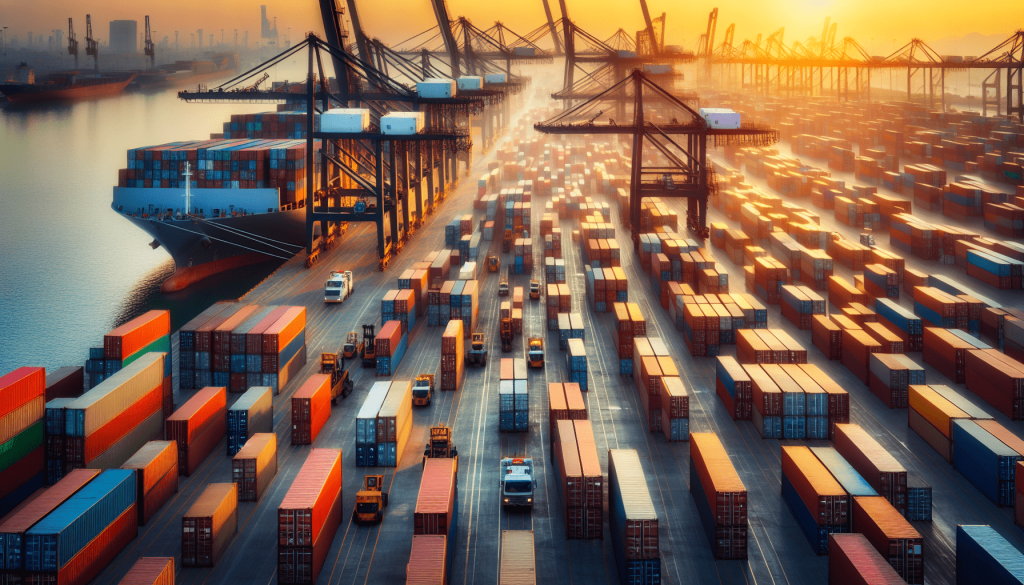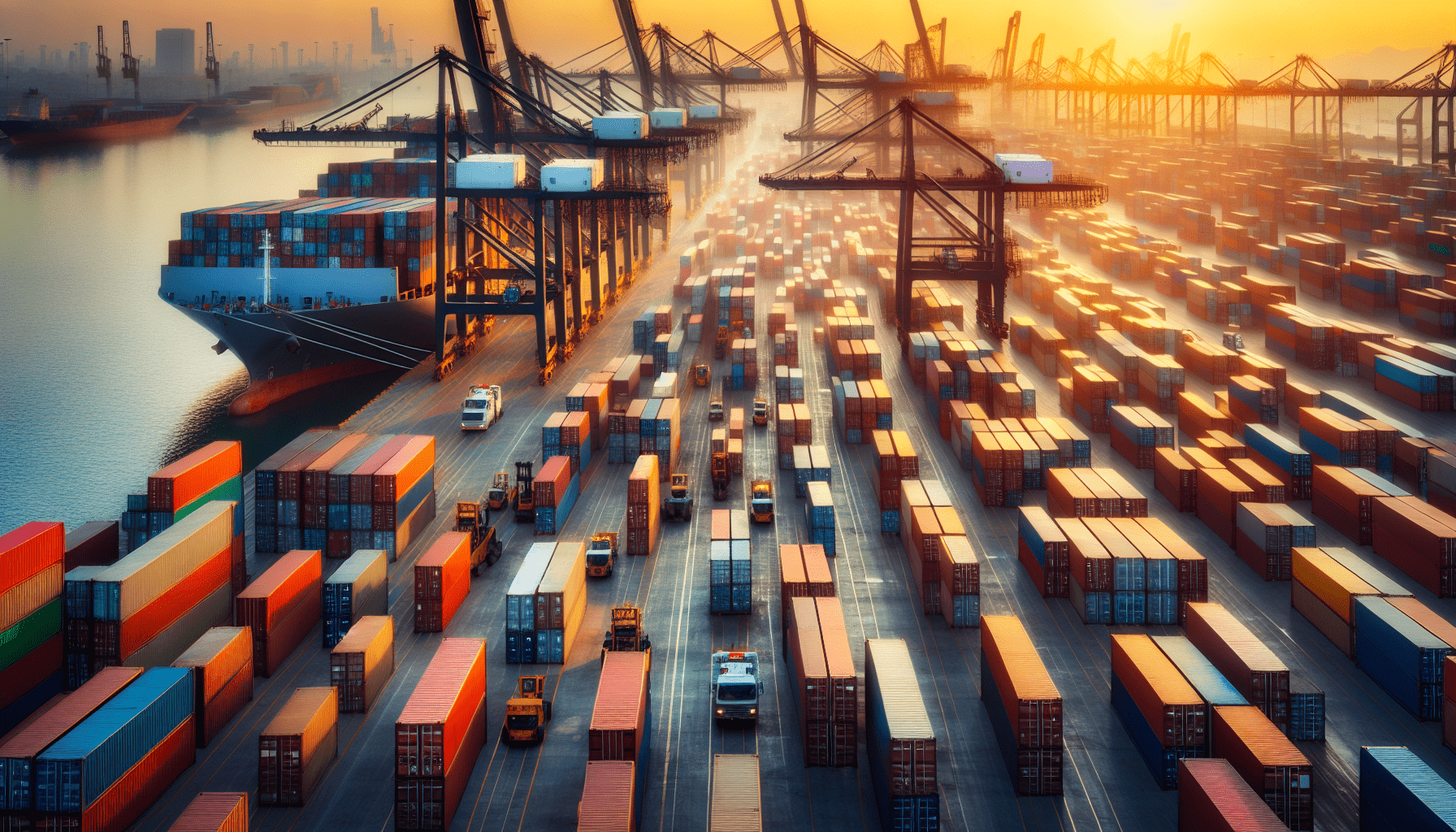Have you ever wondered how those giant 40ft shipping containers make their way from one location to another? Well, the process might surprise you. From their initial loading at the port to their final destination, these mammoth containers embark on a fascinating journey, aided by ingenious engineering and skilled professionals who ensure their safe and timely delivery. So, let’s take a closer look at the fascinating world of 40ft shipping container transportation and discover the methods used to transport these colossal cargoes.

Delivery Methods
When it comes to shipping containers, there are several different delivery methods available depending on your needs and preferences. These methods include truck delivery, rail delivery, container ship delivery, barge delivery, and air delivery. Each method has its own unique advantages and considerations, so let’s take a closer look at each one.
Truck Delivery
Overview
Truck delivery is one of the most common and versatile methods for delivering shipping containers. With a fleet of trucks readily available, shipments can be transported quickly and efficiently to their destination. Whether you need to deliver a container locally or across the country, truck delivery provides a reliable and convenient option.
Container Placement
When it comes to truck delivery, container placement is an important consideration. Most containers are designed to be transported on flatbed trailers, which are equipped with hooks and locks to secure the container during transportation. These trailers are loaded onto the back of the truck, and the container is then securely fastened to prevent any movement or damage during transit.
Delivery Challenges
While truck delivery offers many benefits, there are also some challenges to consider. One of the main challenges is navigating through narrow streets or areas with limited access. In urban areas, where space is often limited, it can be challenging to maneuver a truck and trailer carrying a shipping container. Additionally, weight restrictions and height clearances may impose limitations on certain routes.
Common Equipment Used
To facilitate truck delivery, there are several common equipment options that are used. Flatbed trailers, as mentioned earlier, are the most commonly used trailers for transporting shipping containers. They provide a stable and secure platform for carrying the containers. Tilt trailers are also used, which can tilt to help with the loading and unloading process. Side loader trailers, on the other hand, have the ability to load and unload containers from the side, which can be beneficial in tight spaces. Cranes and lifts are commonly used to lift and position containers onto the trailers, while forks and spreaders are used to securely grip and lift the containers.
Rail Delivery
Overview
Rail delivery is another popular method for transporting shipping containers. It offers a cost-effective and environmentally friendly option for long-distance transportation. With railway networks spanning vast distances, rail delivery is well-suited for shipping containers across countries and continents.
Intermodal Containers
One of the key aspects of rail delivery is the use of intermodal containers. These containers are designed to be easily transferred between different modes of transportation – from trucks to trains and even ships. Intermodal containers are standardized in size and shape, often measuring 20 or 40 feet in length, making them compatible with various transportation methods.
Container Placement
Similar to truck delivery, containers transported by rail are placed on specialized railcars. These railcars, also known as flatcars, have been specifically designed to accommodate the size and weight of shipping containers. Containers are loaded onto the flatcar and secured using twist locks or other locking mechanisms to ensure stability and safety during transit.
Benefits of Rail Delivery
Rail delivery offers several advantages that make it an attractive option for shipping containers. First and foremost, it is a cost-effective method, especially for long-distance transportation. Railways can carry a large number of containers in a single journey, reducing the overall transportation costs. Additionally, rail delivery is considered to be more environmentally friendly compared to other methods as it consumes less fuel and produces fewer emissions.
Container Ship Delivery
Overview
Container ship delivery is a widely used method for transporting large volumes of shipping containers across the world’s oceans. With their immense capacity, container ships can carry thousands of containers, making this method ideal for international trade and global shipping.
Port Operations
Container ship delivery relies heavily on port operations for loading and unloading containers. When a container ship arrives at the port, cranes are used to lift and transfer the containers onto the dock. From there, specialized equipment, such as straddle carriers or reach stackers, is used to transport the containers to the designated storage areas within the port.
Container Stacking Methods
Once at the port, containers need to be stacked efficiently and securely. There are different methods for container stacking, including stacker crane systems, yard cranes, and automated storage systems. These methods ensure that containers are stored in an organized manner, maximizing the use of available space and facilitating easy access for future retrieval.
Benefits of Container Ship Delivery
Container ship delivery offers numerous benefits, especially for international trade. The large capacity of container ships allows for the transportation of significant volumes of goods, resulting in economies of scale. This makes shipping containers by sea a cost-effective option for businesses. Additionally, container ship delivery provides a reliable and predictable schedule, allowing for better planning and coordination of supply chains.

Barge Delivery
Overview
Barge delivery is a unique method of transporting shipping containers on inland waterways. This method is particularly useful when shipping containers need to be transported to destinations that are not accessible by trucks or rail.
Inland Waterways
Barges are flat-bottomed boats specifically designed for navigating through rivers, canals, and other inland waterways. They can transport shipping containers between ports, riverside factories, and other locations along the waterways. Barge delivery is commonly used for regional transportation and connecting inland regions to larger ports and shipping hubs.
Container Placement
Similar to truck and rail delivery, shipping containers on barges are placed on specialized platforms or decks. These platforms are equipped with twist locks and other securing mechanisms to ensure that the containers remain stable during transportation. Barges are typically loaded and unloaded using cranes or other lifting equipment at the ports or designated loading areas.
Benefits of Barge Delivery
Barge delivery offers several advantages that make it a preferred choice in certain situations. It is a cost-effective method for transporting large volumes of goods, especially when using inland waterways as opposed to more expensive land-based transportation methods. Barge delivery is also known for its reliability and consistency, as it is not subject to traffic congestion or weather-related delays on roads or railways.
Air Delivery
Overview
Air delivery, although not as commonly used for shipping containers as other methods, offers an expedited and efficient option for transporting time-sensitive or high-value cargo. While it may come with higher costs compared to other methods, air delivery can be invaluable when speed is of utmost importance.
Specialized Cargo Aircraft
Air delivery of shipping containers utilizes specialized cargo aircraft designed to accommodate the size and weight of these containers. These aircraft are equipped with large cargo holds or specialized containers that can be loaded and secured using aircraft loading systems. The containers are often secured to the aircraft to prevent movement during flight, ensuring the safety of the cargo.
Airports and Runway Requirements
Airports play a crucial role in facilitating air delivery of shipping containers. These airports must have adequate infrastructure, including large runways and cargo facilities, to accommodate cargo aircraft. Additionally, they require suitable infrastructure for lifting and positioning the containers onto the aircraft. Major cargo airports are equipped to handle oversized and heavy cargo, making them ideal for air delivery.
Benefits of Air Delivery
Despite being a relatively expensive option, air delivery offers several important benefits. The most significant advantage is speed. Airplanes can cover vast distances in a short period, allowing for swift delivery of goods. This makes air delivery highly suitable for time-sensitive shipments, perishable goods, or urgent situations where delays are not acceptable. Furthermore, air delivery provides enhanced security and protection, as it involves strict airport security measures and reduces the risk of theft or damage to the cargo.
Delivery Challenges
While each delivery method has its respective advantages, there are also challenges that need to be addressed in order to ensure successful and efficient delivery of shipping containers.
Infrastructure Limitations
One of the main challenges is infrastructure limitations. Different delivery methods rely on specific infrastructure, such as road networks, railways, ports, waterways, or airports. Insufficient or inadequate infrastructure can hinder the smooth flow of goods and increase transportation costs. It is crucial for governments and organizations to invest in the development and maintenance of infrastructure to support the effective delivery of shipping containers.
Legal and Regulatory Requirements
The transportation of shipping containers is subject to various legal and regulatory requirements. These requirements may include obtaining permits, complying with weight restrictions, adhering to safety regulations, and meeting customs and border control requirements. Ensuring compliance with these requirements can be complex and time-consuming, especially when shipping containers cross international borders. It is essential for businesses and shipping companies to stay up to date with the relevant laws and regulations to avoid any legal issues or delays.
Logistical Coordination
Coordination is another challenge in shipping container delivery, especially when it involves multiple modes of transportation. Coordinating the movement of containers between trucks, trains, ships, barges, or aircraft requires careful planning and communication between different parties involved. Proper coordination helps optimize the delivery process, minimizing delays and ensuring the timely arrival of goods.
Weather Conditions
Weather conditions can pose significant challenges to shipping container delivery, especially for methods that rely on outdoor transportation. Severe weather events, such as storms, hurricanes, or heavy snowfall, can disrupt transportation routes, delay shipments, or even damage containers. It is essential to consider and plan for weather conditions when choosing a delivery method and to have contingency plans in place to mitigate any potential disruptions.
Common Equipment Used
To facilitate the delivery of shipping containers, various equipment is commonly used to ensure safe and efficient transportation.
Flatbed Trailers
Flatbed trailers are one of the most commonly used types of trailers for transporting shipping containers. They provide a stable and secure platform for carrying containers, allowing for easy loading and unloading.
Tilt Trailers
Tilt trailers have the ability to tilt, making it easier to load and unload containers. This feature is particularly useful when dealing with heavy or oversized containers that cannot be lifted by cranes or lifts.
Side Loader Trailers
Side loader trailers are equipped with specialized cranes that can load and unload containers from the side. This feature is beneficial in situations where there is limited space or restricted access for traditional loading and unloading methods.
Cranes and Lifts
Cranes and lifts are commonly used to lift and position shipping containers onto trailers, railcars, or onto ships. These heavy-duty lifting equipment ensure safe and precise handling of containers.
Forks and Spreaders
Forks and spreaders are attachments used with cranes and lifts to securely grip and lift shipping containers. They provide the necessary stability and control when loading and unloading containers from various transportation modes.
Benefits of Container Delivery
The delivery of shipping containers offers several benefits that make it a preferred choice for transporting goods.
Efficiency and Time Savings
Container delivery methods are known for their efficiency and time-saving capabilities. Containers can be easily loaded, secured, and transported, minimizing the time spent on handling and logistics. The standardization of container sizes and the use of specialized equipment further streamline the transportation process, reducing delays and enhancing overall efficiency.
Flexibility and Accessibility
Container delivery provides flexibility and accessibility in terms of transportation routes and modes. Containers can be seamlessly transferred between trucks, trains, ships, barges, or aircraft, allowing for easy integration into various logistics networks. This flexibility enables businesses to choose the most efficient and cost-effective delivery method based on their specific needs and circumstances.
Cost-Effective Transport
Container delivery methods are generally considered cost-effective, especially for large volumes of goods or long-distance transportation. The economies of scale achieved through the use of standardized containers and efficient transportation modes help reduce overall costs. Additionally, container delivery minimizes the need for additional packaging or handling, further reducing expenses.
Security and Protection
The use of containers provides enhanced security and protection for goods during transportation. The durable construction of shipping containers safeguards goods from theft, damage, and adverse weather conditions. Containers can also be sealed and monitored, ensuring the integrity and confidentiality of the cargo. This provides peace of mind to businesses and customers, knowing that their goods are secure throughout the delivery process.
Conclusion
In conclusion, the delivery of shipping containers involves various methods, each offering its own set of advantages and considerations. Truck delivery provides convenience and accessibility, while rail delivery offers cost-effectiveness and environmental benefits. Container ship delivery is ideal for international trade and large volumes of goods, barge delivery connects inland regions, and air delivery provides speed and efficiency. Despite the challenges, such as infrastructure limitations and regulatory requirements, the use of specialized equipment and standardized containers further enhance the efficiency and reliability of container delivery. Whether it’s for local transportation or international trade, shipping containers have revolutionized the logistics industry and continue to play a vital role in the global movement of goods.

I am James, the creator behind SeaBoxInnovations.com. Welcome to our premier online destination dedicated to the world of sea containers. Think Inside the Box is our tagline, and our website is your go-to source for exploring the endless potential of these versatile and adaptable containers. Whether you’re interested in purchasing, customizing, or learning about the latest trends in container architecture and design, we have you covered. Join us as we bridge the gap between traditional uses and cutting-edge applications, promoting sustainability and innovation in design and construction. Get ready to embark on your next big project with SeaBoxInnovations.com.

